Original URL: https://www.theregister.com/2009/08/24/review_e_car_honda_insight/
Honda Insight five-door hybrid
Less pious than the Prius?
Posted in Science, 24th August 2009 12:02 GMT
Review In the race to popularise the hybrid, Honda has been shown a clean pair of heels by Toyota. This situation is graphically underlined by the fact that Toyota's Prius is currently on its fourth incarnation since its launch in 1997, while the Honda's Insight is only on its second since 1999. Between 2006 and the launch of the new model, the Insight didn't exist at all.
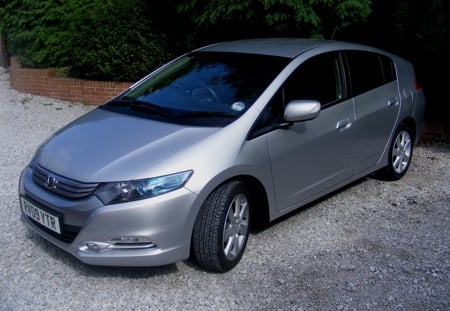
Honda's Insight: hard to tell apart from the Prius?
So has the new Insight been worth the three-year wait?
It probably wasn't ideal timing for the new Insight to arrive on the forecourt at the same time as the latest Prius. After all, they look alike, have broadly similar powertrain concepts and are probably the only two hybrids the man in the street could name if you stopped him and asked.
The Insight's exterior styling is certainly eye-catching but it's also not wholly dissimilar - again - to the latest Prius. Honda prefers to emphasise the Insight's similarity to its hydrogen-powered big brother, the FCX Clarity. Line all three cars up and remove the badges, and many people would struggle to tell them apart, suggesting that this is the shape you get when you ask a large computer to design an aerodynamically efficient five-door hatchback.
Honda hasn't revealed the Insight's coefficient of drag, but we'd be very surprised if it's far off the Prius' figure of 0.25 – an identical figure to that of the original and ruthlessly streamlined Insight. Unlike the Civic Hybrid, the Insight doesn't use wind-cheating wheel trims. Apparently, European car buyers think they are as ugly as sin.
Slippery the design maybe, but that wind-cheating roof line and narrow rear comes at the expense of rear visibility which is very poor and made worse by the solid bar that divides the upper and lower parts of the tailgate window. Even with the elephant-ear wing mirrors, reversing can be a worryingly hit and miss affair.
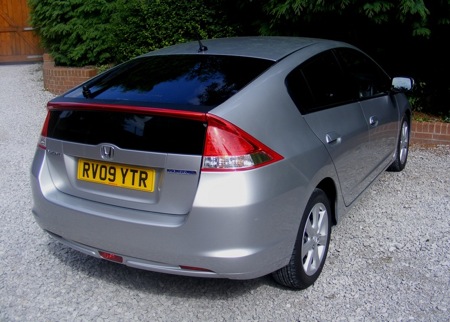
The slippery design comes at the expense of rear visibility
Hybrid electric drive comes courtesy of a 13.8bhp (10.3kW) electric motor that also produces 58lb-ft of torque. That's a considerably less powerful leccy motor than the one to be found in the Prius, which is rated at 80bhp and 153lb-ft.
As the Insight's NiMH battery only has a capacity of 580Wh, the lion's share of the work is done by the 1.3l four-cylinder i-VTEC petrol engine, which produces 88bhp at a rather high 5800rpm and 89lb-ft of torque at 4800rpm.
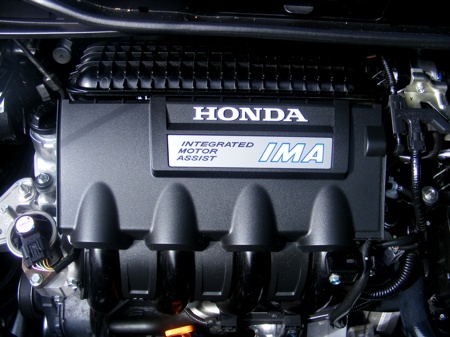
The leccy part
Looking at those figures, you'd expect any sort of urgent progress to be accompanied by some fierce revving and you wouldn't be disappointed. Being a Honda engine, it revs sweetly and quickly, but with less than 14bhp of 'assistance' on call from the electric motor, if you press on it rapidly becomes obvious you are driving a rather large car with rather a small engine.
The petrol and electric motors are joined at the hip by a constantly variable transmission (CVT), a design that by its very nature exacerbates the revs-before-progress feel of the car. Honda says the Insight will get to 62mph in 12.5 seconds and roll on to a top speed on 113mph, but in day-to-day use it actually feels rather slower than those numbers suggest.
While the electric motor assistance is a little on the weak side for effective mid-range acceleration on the open road, the extra power is enough to help make a quick getaway from the lights when driving in town.
During the test, we noticed that the indicated battery charge never seemed to fall below 50 per cent, leading us to wonder if the Insight couldn't also do with a more powerful motor to take advantage of the charge that was just sitting in the battery twiddling its leccy thumbs.
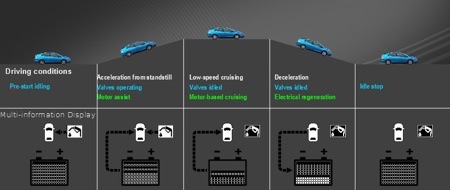
Petrol engine and leccy motor interplay
Assuming you buy an Insight to save on fuel rather than for outright performance, you shouldn't be too disappointed. The very worst we managed was 42.3mpg and that was during two solid days spent driving around central Manchester in very heavy urban stop-start traffic. On the open road, the best we managed was 55.3mpg, while the average during our week with the car was 49.8.
Urban economy is helped by a very efficient stop/start system, just keep your foot on the brake and the engine switches itself off. Take your foot off and the engine starts.
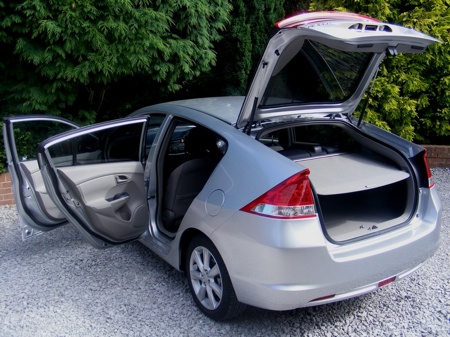
A true family-sized five-door, five-seater
The Insight's CO2 emissions are rated at 105g/km, which is enough to get you into the VED Band B £15-a-year car tax bracket but is a higher emissions figure than the 104g/km that Volvo claims to get from its new DRIVe 1.6 turbo diesel C30 and V40 models. Register Hardware has driven both those cars and managed to get a very similar fuel consumption figure to the Insight's. Frankly, both felt faster and where rather more fun to drive. Unlike Honda, Volvo thinks car buyers after an eco-ride will put up with visually challenging low-drag wheel trims.
Of course, when it comes to CO2 the Prius goes one better and only pumps out 89g/km. That means Band A and no car tax.
Whereas Toyota's Synergy Drive system allows the Prius to operate in a low-speed EV or electric-only mode with the petrol engine wholly out of the equation, that's not a trick the Insight's Integrated Motor Assist system can pull off. This is down to the Insight having a simpler - and thus cheaper - drive train than the Prius.
While the Insight is capable of running on battery power alone, the transmission is still turning the engine over as it does so. While this is happening, the Variable Cylinder Management (VCM) system closes the cylinders so no fuel is being burnt but in terms of engine noise you don't notice the difference between low-speed driving using the petrol engine and low-speed driving using the electric motor. The upside of this is that the transition between petrol, electric and hybrid drive is totally seamless. The downside is that the engine is still imposing drag on the system and so draining the battery faster than is strictly necessary.
According to Honda, battery-only drive only occurs when you're cruising at below 50kpm (31mph). During our test, we only managed to obtain reliable and long-term battery motoring while stuck in a slow-moving tailback on the M6 and travelling at around 15mph. A shade under two miles was the best be managed before traffic speed picked up and the engine kicked in.
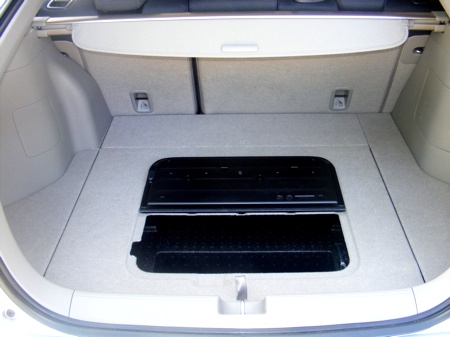
There's a cubbyhole in the boot - but no spare wheel
On one rare occasion, we saw the dash indicate battery-only propulsion at a shade over 50mph, which shouldn't be possible. That may have had something to do with the fact that it was one of the odd instances on the open road when the battery was showing a 100 per cent charge, so presumably the system was looking for ways to use the charge effectively and not run the risk of having to 'waste' energy from the regenerative brake generators.
For good or ill, Honda has decided to turn the Insight's highly illuminated and colourful dash into what it presumably thinks is an environmentalist's delight. So beyond the floating LED speedometer that changes its ambient glow from green – all is well with the biosphere - through pale blue to dark blue – you are single-handedly causing a Malthusian crisis with your driving style - you also get 'awarded' tree-like symbols with various degrees of foliage to rate how environmentally friendly your driving style is. If it all sounds a bit patronising that's because it is.
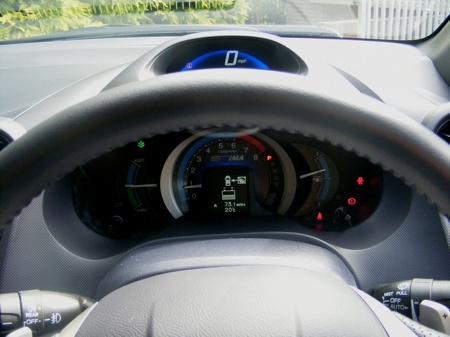
A slightly patronising dashboard
Despite not trying to be overly environmentally responsible, we still managed to get four trees out of a possible five during our test, suggesting the regime isn't all that stringent. Get all five trees and, when you switch the engine off, a little trophy appears. Seriously, it does. This sort of Tamagotchi twaddle may play well in the Asian market but we doubt it will here.
Of rather more use is the screen on the multi-function display that shows you how power is flowing between the engine, battery and regenerative braking system. A gauge to the left of the rev counter gives a more detailed illustration of the degree to which the battery is being either depleted or charged.
The Insight also has a big green ECON button. Hit this and the engine management system and transmission profiles alter themselves subtly to improve economy. To be honest, we couldn't feel any difference between having the system on or off and were left wondering why ECON wasn't simply the default - and only - setting for the power train.
Patronising dash aside, the interior of the Insight is generally a nice place to be. The seats are very comfortable and supportive; cup holders and cubbyholes abound; the steering wheel is both the right size and thickness and comes with all the built-in controls you would expect, including those for the stereo and cruise control. The only blemish is the exposed cigarette lighter which looks like it has come from a 1985 Accord and single-handedly blights the cabin's feeling of quality and modernity.
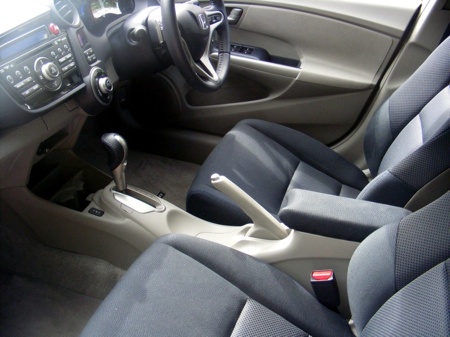
A nice place to be
The ES and ES-T trim levels come with a seven-speed flappy paddle transmission override. Fun though this can be – for a short while, anyway – we aren't entirely sure why it's being offered on car designed to be as economical as possible as all it really does is encourage you to trash your fuel economy.
Our test car came with a more than respectable amount of peripheral kit, including a stereo-linked USB port handily tucked away under the front centre arm rest; a leather steering wheel and gear shift nob; and heated front seats, though the latter seemed a bit pointless in a car with cloth upholstery and just another unnecessary drag on the car's fuel economy.
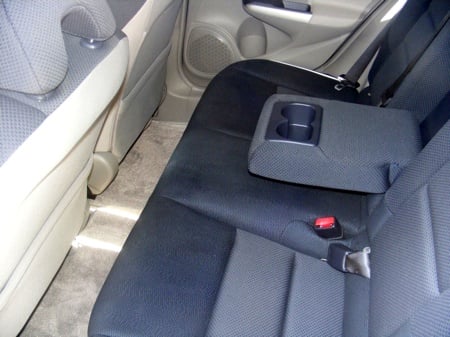
Cup holders abound
Despite sharing its platform and suspension with the Jazz, the Insight is closer in size to the Civic and is a true family-sized five-door, five-seater capable of carrying six-foot adults front and back at the same time. The boot is reasonably capacious too and has a sizeable hidden compartment in the floor. No spare wheel, though, so if you get a puncture you need to call the AA or use the can of get-you-home tyre inflater.
On the open the road, the Insight is typical medium-sized front-wheel drive Honda, so the handling is safe and predictable while the ride is firm but supple on smooth tarmac. Get onto the broken stuff and bumps and thumps become more noticeable. Hit at large pot hole and by God you will know about it, the Insight crashing into them with reckless abandon. This sort of limited suspension travel crash will be familiar to many Jazz or Civic drivers but is easily solved by going around the holes in the road rather than over or into them.
The regenerative braking system has no noticeable effect on the car's driving dynamics. Jump on the anchors and everything feels exactly the same as it would were you driving any other mid-sized ABS-equipped Honda. All Honda needs to do now is work out how to store and recycle the overpowering feeling of smugness people seem to feel while driving the Insight. If it can crack that, it will have single-handedly managed to secure mankind's energy future.
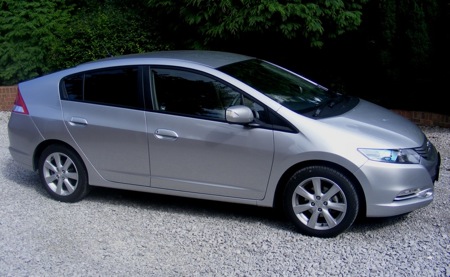
Beats Prius on price
One area where the Insight has the Prius clearly beaten is price. A basic Insight will set you back a shade under £16,000 on the road. That's £2500 less than an entry-level Prius. The only problem with buying the base Insight is the standard 15in wheels, which do nothing for the car's stance. So do the clever thing and buy the base model but haggle with the dealer for a set of the 16in alloys that come as standard on the rest of the range. Ask for the USB audio connector too.
Verdict
The Insight is rather more than the sum of its parts and not a bad old bucket of bolts. It's well made, and comfortable and relaxing to drive on decent roads as long as you don't treat it as a sports car. It's also meagre with the fuel it takes in and the CO2 it pumps out.
But we think the electric part of the car should have been engineered to play a larger part in proceedings. Given a more powerful electric motor and/or battery, the Insight would be capable of faster and less frenetic acceleration, and a wider range of battery-only propulsion. That would make it more fun to drive for those of us to whom economy is not the be all and end all, and would also probably improve urban fuel economy by allowing the engine valves to remain shut more of the time. With any luck, the CR-Z sports hybrid will address both those issues when it arrives next year. ®
